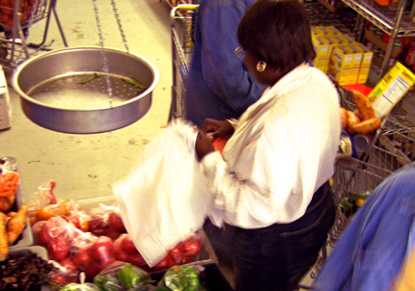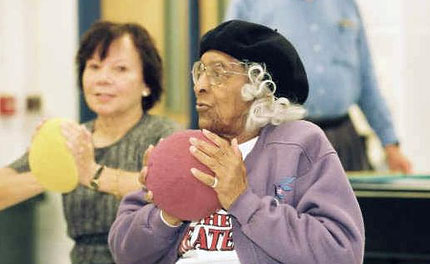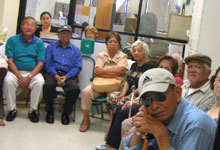Bringing Customer Choice to Food Pantries

food pantries in the city.
For the hungry, the routine at most of the city's 600 food pantries goes something like this: Line up outside with dozens of fellow New Yorkers in need of food. Wait in the cold or inclement weather for an hour or so. Collect a bag of groceries, and hope that what is inside can fill the gaps in the cupboards at home.
Stepping in to the pantry of the Bed Stuy Campaign Against Hunger is a different experience. In fact, it is more akin to walking into a supermarket. Sign in, pick up a basket or grocery cart and make your way through aisles stocked with bread, milk, cereal, rice, beans, canned fruits and vegetables - you name it. An industrial-sized refrigerator with chicken and veggie burgers sits behind the checkout counter, along with boxes of fresh produce. When you have picked out everything you need, check out at the register using a point system based on the size of your household, bag your own groceries and go about your way.
In its second year of operation, the Bed Stuy Campaign Against Hunger at 2004 Fulton Street operates this "client choice" food pantry, one of only four in the city. Two such pantries are located in Brooklyn and one on Staten Island, with the West Side Campaign Against Hunger the lone example in Manhattan.
A Growing Demand
The Bed Stuy pantry feeds more than 6,000 New Yorkers every month, half of whom are children. Overall, more than one million New Yorkers rely on emergency food at some point during the year, according to City Harvest, a non-profit food rescue organization, and the numbers are increasing.
While a recent rise in the price of basic food staples like milk, eggs, flour and sugar has pinched household budgets nationwide, rising rents and a rash of mortgage foreclosures are hitting low and mixed-income neighborhoods like Bed Stuy especially hard. The people running the pantry have noted a major rise in the number of clients over the last year, especially among the elderly.
"We had to turn away hundreds of customers last fall, October through December," said Tamara Dawson, the pantry's program coordinator. "We kept running out of food." On a recent weekday afternoon, Dawson said the pantry's current supply of milk, rice, and pasta likely wouldn't last through the end of the week.
People on a fixed income are most affected. "When you only get one check a month, you have to make it stretch like chewing gum," said Mary Sweeney, 68, an appreciative customer who traveled by bus from Brownsville.
The Pleasure of Choice
"Client choice" food pantries like the one in Bed Stuy help alleviate some of the stigma involved in visiting a food pantry. "A lot of our clients already feel a little embarrassed about coming to a pantry, so they love how we designed our pantry. It's common sense," said Tom Neve, coordinator of the all-volunteer pantry at Reaching Out Community Services in South Brooklyn.
"It's more dignified for the clients," said the Reverend Melody Samuels, executive director of the project. "They can shop with pride."
Instead of picking up a readymade bag that may or may not contain food the customer wants or needs, client choice pantries let shoppers tailor their food choices based on their own tastes, cultural background or dietary restrictions. This kind of pantry also represents a more efficient way to provide emergency food to people who need it, by integrating client feedback into purchasing and stocking decisions the pantry staff must make on a weekly basis.
"You only take what you want here. There's less waste," said Noreen McClowd, a client at the pantry who also volunteers once a week.
In fact, when the pantry was run out of the G.R.A.C.E. Church basement, before moving to the other side of Fulton Street near Ralph Avenue in December 2006, waste was a problem, according to Dawson,. She and her volunteers would often find bags of unwanted dry goods left outside the pantry doors.
"Now our clients have a choice so they tend to pick out just what their family needs, not what somebody else thinks they might need," said Dawson. "And that helps us save money."
The Bed Stuy pantry is modeled after the West Side Campaign Against Hunger in Manhattan, considered to be the first supermarket-style food pantry in the country. It is a cooperative, which means that all the customers work at least one shift a month, helping with stocking, checkout or clerical work. Clients can pick food based on their diet and health issues, and perhaps most importantly, the cooking facilities they have access to, said Doreen Wohl, director of the program.
"If you are homeless it may not be in your best interest to go to a pantry and take away a lot of fresh produce that is perishable," said Wohl. "The prepackaged grocery bag doesn't distinguish that."
The history of the West Side pantry says a lot about the collaborative relationship it has built with its customers. One cold day in the spring of 1993, an assistant who was paid to pack grocery bags was late for work. With tens of clients lined up outside the door, many of them seniors, Wohl went outside and asked if they'd like to help.
"They all just came alive, and everybody was anxious to help," said Wohl. "That's when we really changed our orientation. We used to call them clients, now we call them customers. It's about trust. We trust in the customer and the knowledge they bring to us about their diets, their illnesses or their family background."
The Problem of Choice
Still, the client choice model is more difficult to run, requiring thorough attention to customers' dietary restrictions or health needs. More thought and preparation is put into deciding what to stock and what to leave off of the shelves. The pantries' food supply comes from a mix of donations, from individuals and businesses, but mostly from the Food Bank for New York City, the largest distributor of free food in the city. The pantries also have a budget to purchase other items in bulk. This leaves them vulnerable to periodic shortages, such as the one that occurred last fall, when there was a significant dip in federal emergency food aid and many pantries across the city were forced to turn people away.
"Nothing is easier than just giving out standard, prepackaged bags," said Neve.
Neve also acknowledged that space is an issue for the Campaign Against Hunger. It is easier to develop a choice-based, grocery market style pantry when there is ample room to set up shelves and store food stock nearby, preferably in the same building. For pantries that are run out of a church basement, this may not be a real option. The Bed Stuy Campaign Against Hunger was able to sign a long-term lease on a small warehouse space in 2006. The Reaching Out food pantry just moved to a new, larger space in November. As a result, Neve said, it has seen a big jump in people coming through the door, particularly seniors on fixed incomes and single parents.
When all of the elements fall into place and the client choice system works, patrons obviously appreciate it. John Bailey, 58, is a regular volunteer at the pantry in Bed Stuy who greets customers with a big smile. He helps explain the point system to new arrivals, discussing how it awards points based on the size of the household and whether any of its members of the house have illnesses such as diabetes or hypertension that would affect their diet. Bailey likes the way the pantry is organized-and it has had a direct influence on his cooking habits.
"What God gives me I take," said Bailey. But thanks to having some choice at the pantry, he said, he's honed a few recipes, including sweet potato pie. "When they have sweet potatoes in stock, I always go for those. My friends and neighbors tell me my pies are getting better with each try."
Joseph Huff-Hannon is a writer on culture and politics, based in Brooklyn.Â
Aging in a New Era

Aging has come of age.
By 2030, according to the Bloomberg administration, New York's over-60 population, now at 1.3 million, will increase by 44 percent. The 85-plus group, the fastest growing segment of the population, has grown by 19 percent since 1990.
Life can be challenging for these New Yorkers. Many live alone. Twenty percent have incomes below the poverty line. A recent study by the Council of Senior Centers and Services found that 35 percent of seniors interviewed were experiencing "food insecurity," from worrying about food to skipping meals to being hungry.
In an effort to address this, the Bloomberg administration is looking to "modernize" its approach to providing senior services. While the city deserves credit for planning for the aging of its population, the way it has gone about it has raised concerns among the senior advocacy community.
The administration has reduced the number of service providers and moved away from a community-based system. It plans to shut some senior centers and change the delivery of Meals on Wheels. Such changes, many of us believe, will lead to a system that will be less attentive to the needs of individual seniors, who range in age from 60 to 100 and represent a diverse group of ethnicities, nationalities, abilities and disabilities and economic status. The budget cuts demanded of all city agencies only make the situation worse.
The modernization plan tackles three major areas: Meals on Wheels, senior centers and case management for the homebound elderly. All raise particular concerns.

Meals on Wheels
The Department for the Aging plans to reduce 97 Meals on Wheels contracts to agreements with 10 to 20 contractors who would serve "regions."
For years, Meals on Wheels delivered prepared meals daily to the homebound elderly. Since 2004, however, 17 community contractors in the Bronx were consolidated into three large regions doled out into two contracts. This has resulted in the same meal, either hot or frozen, being provided throughout the borough and, in some cases, meals being delivered only twice a week. According to the Independent Budget Office review of the program, there has been no meaningful cost savings.
Now the administration plans to expand this approach. Older people and advocates have raised a number of objections.
For one, the change means a homebound senior will have less frequent visits. It disregards the development of a relationship between the person delivering the meal and the senior, which consequently increases the possibility that a senior could experience social isolation. It also means the elderly are less likely to get special extras, like birthday cake or holiday food.
In Brooklyn today, individual contractors prepare Meals on Wheels locally in Chinese and Latino Sunset Park, Russian and Chinese Brighton Beach and Sheepshead Bay, African-American and Caribbean Flatbush, Italian and Russian Bay Ridge, Latino and African American Red Hook and on and on. Now Brooklyn could have just two or three Meals on Wheels regional contracts, virtually guaranteeing a two-day-a-week frozen meal service prevails as geography and funding drive "choices."
Imagine all of Brooklyn eating pot roast on the same day. While frozen meals may be only one option, the bigger concern is that the shift lacks choice for diverse palates and nutritional needs. How many New Yorkers would be satisfied eating the same as everyone else, and what if they choose not to eat it at all?
The deliveries address more than the seniors' nutritional need. They also provide regular human contact. Recently, in Queens, a Meals on Wheels provider found a senior ill on the floor. This is not an uncommon story. Imagine if the woman fell ill the day after the meal delivery -- would she be alone for three days sick and on the floor?
New York is the last major city with a community-based Meals on Wheels system. We should take pride in this rather than emulating cities like Philadelphia or Los Angeles that have only a few meal providers for the whole city.
Case Management
Case management agencies coordinate care for frail seniors, allowing them to remain in their homes. In May, the administration released a paper on case management that proposed reducing the number of regions administering this service from 32 to 23.
Service providers, advocates, borough presidents and members of the City Council questioned some of the regional boundaries, yet not one was changed. Brooklyn, with the highest number of seniors at about 375,000, lost five contracts when 12 districts were consolidated to seven. Under the new system, case management regions are larger, making it far more difficult to connect the 90-year-old homebound senior with the local resources he or she needs.
Agencies with longstanding recognition in these communities lost their case management contracts. In Jamaica, the city dropped a leading minority contractor who had handled this service for more than 30 years. There is a similar case on Staten Island.
The consolidation could create upheaval. In addition to juggling larger groups and responsibilities, some agencies do not have prior experience doing case management with the homebound elderly. Across the city, all the contractors will be working with communities they had not served before.
The new contract includes a 3 percent cut -- or about $30,000 -- which is equivalent to the cost of a case manager. This will increase the caseload for the remaining managers.
Senior Centers
Senior centers provide myriad reasons for the elderly to get out of bed each day and go out. Those are the words seniors themselves use.

The aging department proposes to "regionalize" all 329 senior centers simultaneously. It remains unclear how this will be accomplished and how many centers will exist under the plan. At public forums, the department has stated that the number of senior centers will decrease.
If a senior center moves from one part of a community to another, it may become inaccessible to the 85-year-old who walked there. He or she will simply stop going. That could lead to social isolation, which, in turn, can lead to further mental and physical deterioration.
Elderly immigrants, whose first language is not English, face formidable challenges navigating life in New York. Many senior centers offer welcoming havens for immigrants. Bilingual staff, culturally oriented programming and food are staples. So, if the center serving the Korean population in Queens closes, will those seniors attend another center that feels foreign to them?
There is an industry rule of thumb that seniors will travel within a 10-block radius to get to a senior center. I worked in a senior center in Park Slope in the 1980s that later moved to the other end of the neighborhood. One 90-year-old, who I was very fond of, tried for a while to take the bus to the new location, but eventually gave up. It was too hard, especially in bad weather. For most younger people, the distance would not seem that hard to navigate. For her, it was insurmountable.
The administration has suggested dividing up the $94 million spent on senior centers by community district. This seems intended to close some centers to free up funding, while it also threatens van services that are operated from individual senior centers. The shift would force senior centers to compete for the money as though from scratch. Because of this uncertain funding formula, much of what senior centers provide appears to be at risk, from transportation to social services to programs.
Funding Questions
All of this restructuring comes when as much as $20 million worth of funding in general is threatened.
Funding for seniors is always a complicated dance. As the city looks to reorganize services, it needs to acknowledge that these programs have been historically underfunded.
Last year, the City Council added $12.5 million to senior programs. That money is not in the mayor's preliminary budget for next year. Even if that funding eventually is restored, the aging department is putting out requests for bids now, and those bids must incorporate the cut. That means 35 cents less a meal, $7,800 or more less per van and loss of rent funds for senior centers.
With the economic downturn, the Department for the Aging, like other city services is being asked to make additional cuts for the 2009 fiscal year. It does not have to be that way. The state is facing a budget deficit, but the former Gov. Eliot Spitzer's budget gave the state Office for the Aging a 9 percent increase, $12 million, because state officials understand the value of investing in services to help seniors age with dignity in their communities.
Beyond the Community
In general, the Bloomberg administration sees big contracts with big regions as an efficient model to provide services. But many programs for seniors have achieved success by growing organically within local neighborhoods.
Community-based services address quality of life issues. Saying "change is difficult" sounds hollow to elderly people who can no longer get to a center or receive an appropriate home-delivered meal.
Senior service agencies aren't against change, but successful change needs to take place in an environment of flexibility and with adequate time, planning and resources to implement those improvements.
By the end of 2008 most of the senior service contracts will have been restructured and could be held by entirely different providers. Not only is this too fast for service providers, but more importantly, it is too fast for the elderly. For example, an 80 or 90-year-old homebound person stands to lose their case manager, Meals on Wheels deliverer and senior center that prepared the meal all within six months.
Moving service areas around does not necessarily improve quality of service, address diversity or prevent waiting lists for services. This is a turning point in aging services. Sufficient time and thoughtful planning are essential. The city can't just look at service regions by the thousands. It is individual care that counts.
Bobbie Sackman is Director of Public Policy for the Council of Senior Centers and Services. ÂA Treatment that Follows Drug Users
Traditional drug treatment for teens often means being sent to an inpatient facility, far from family and friends. The young people might stop abusing drugs but then, soon after they return to their neighborhood they revert to their old ways.
A program developed by the non-profit Vera Institute has been trying to address this problem with a different kind of treatment: short-term therapy, in a teen's home, with the teen's whole family.
In partnership with the Office of Children and Family Services and other New York state and city agencies, Vera has been testing the program, called Adolescent Portable Therapy, with teens in juvenile detention.
" We recognized that there was a population of kids and families whose needs were not being met, who needed a different kind of intervention," said Evan Elkin, the program's director.
Researchers found that one in every five youth admitted to the city's juvenile justice system had been using drugs, usually marijuana, almost every day for the previous month before being admitted to detention. But in detention, many of those teens were not receiving treatment or saw it interrupted when they moved to another placement or returned home. The portable in APT is key: It is designed to be a support that can move with the teen from detention back into the community. The hope is that such portable therapy can help prevent teen drug users from being placed in residential care.
Teens who decide to participate are assigned a therapist who will stick with them no matter where they are placed. The therapists continue to meet with the teens for four or five months after they are discharged from whatever program they're in and readjust to being back in their neighborhood. The program's therapists also meet with the teen's family or other supportive adults and come to the family's home or any other place the teen and family feel comfortable.
" It's family therapy, but we expand the definition of family," said Elkin. "The first thing we do is sketch out a map of the supportive adults in the young person's life."
If a youth is in foster care, a program therapist might work with the foster mother, group home staff or with someone from the birth family.
In addition to its focus on family therapy and treatment wherever the teen is living, what sets APT apart from other programs is its emphasis on the young person's strengths.
" Often kids will be very confused by our approach," Elkin said. "It's not the Alcoholics Anonymous model. We don't want to bring teens in and make them admit that they're powerless. We believe people are inherently able to change and inherently strong."
How It Works
Mike (not his real name), a 17-year-old who entered the program last year, said he liked the individual attention it provided.
" A therapist came to see me, and once I went upstate she called me every week," he said. "She talked to me about how I felt like when I smoked and how I felt now that I was clean, and we compared the two. I realized there was a lot of stuff I'd been missing out on when I was high. And it was just helpful to have someone to talk to."
Eric Kolb, one of the program's therapists, said a lot of the therapy involves figuring out what kinds of situations tempt kids to use drugs and how they can be avoid such situations or cope with in different ways.
" For instance," Kolb said, "say a kid fights with mom at night, and the only way he can get calmed down enough to go to bed is to get high. We'd identify that and then talk about what it is about the fights with mom that get him so upset. And then we'd try to bring mom into that conversation, find out if she could say things differently. We take it moment by moment. We let the family know—these are other things you could try."
Mike was recently discharged to a group home, and his therapist comes to see him there. He said they plan to start family meetings with his biological mom and his little brother, and he'll continue the program for several more months. But he already feels APT has put him on the right track.
" Before, quitting was just something I said," he explained. "I'd tell people, 'Yeah, I'm going to quit,' but I never did. After I started talking with my therapist, I actually wanted to."
This article is adapted from the pages of our partner Youth Communication. Â




